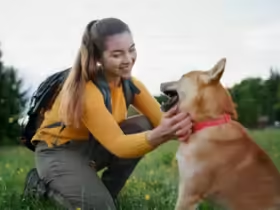Traveling with your furry friend can be a rewarding experience, but it can also be stressful for both you and your pet. Whether you’re heading out on a road trip, flying to a new destination, or taking a train ride, there are several strategies you can implement to ensure your pet remains calm and comfortable throughout the journey. This comprehensive guide will explore effective tips, essential preparations, and calming techniques to help make traveling with your pet a smooth experience.
Understanding Your Pet’s Needs
Before you embark on any travel plans, it’s essential to understand your pet’s specific needs and personality. Different animals respond to travel in various ways, and knowing your pet’s behavior can help you prepare accordingly.
1. Assess Your Pet’s Temperament
- Calm vs. Anxious: Some pets are naturally more anxious than others. If your pet is easily stressed, they may require extra preparation and care.
- Age and Health: Older pets or those with health issues may need special considerations. Always consult your veterinarian before traveling.
2. Familiarize Your Pet with Travel
- Practice Short Trips: Take your pet on short car rides or to nearby parks to help them get accustomed to travel.
- Introduce Carrier or Crate: If you’re using a carrier or crate, allow your pet to explore it at home before the trip, making it a positive space.
Preparing for Travel
Preparation is key to a successful journey. Here are essential steps to take before hitting the road or boarding a plane.
1. Visit the Veterinarian
- Health Check: Schedule a visit to ensure your pet is healthy enough for travel. Obtain any necessary vaccinations or health certificates, especially for air travel.
- Calming Aids: Discuss potential calming aids, such as medications or natural supplements, if your pet is particularly anxious.
2. Choose the Right Carrier or Crate
- Size Matters: Ensure the carrier or crate is appropriately sized. Your pet should be able to stand, turn around, and lie down comfortably.
- Familiar Items: Place familiar blankets or toys inside the carrier to help your pet feel secure.
3. Pack Essential Supplies
Create a travel kit for your pet that includes:
- Food and Water: Bring enough food for the duration of the trip, plus extra in case of delays. Use portable water bowls to keep your pet hydrated.
- Leash and Harness: Always have a leash and harness on hand, especially during stops.
- First Aid Kit: Include basics like bandages, antiseptic wipes, and any medications your pet may need.
- Waste Bags: Be prepared for bathroom breaks by packing waste bags.
4. Plan Your Route
- Pet-Friendly Stops: If you’re traveling by car, plan for pet-friendly stops along the way for bathroom breaks and exercise.
- Hotel Accommodations: Ensure your accommodations are pet-friendly and confirm any specific policies regarding pets.
Tips for a Calm Journey
Once you’re on the road or in the air, there are several techniques you can use to help keep your pet calm and comfortable.
1. Maintain a Calm Demeanor
- Stay Relaxed: Pets can pick up on your emotions. If you remain calm and relaxed, it can help your pet feel more at ease.
- Soothing Voice: Use a gentle, soothing voice to reassure your pet during the journey.
2. Provide Comfort Items
- Familiar Scents: Having items that smell like home, such as blankets or toys, can comfort your pet during travel.
- Comforting Music: Playing soft music can have a calming effect on pets, reducing anxiety during travel.
3. Frequent Breaks
- Stretch and Exercise: If you’re driving, take regular breaks to allow your pet to stretch, relieve themselves, and get some exercise.
- Hydration and Snacks: Offer water and small snacks during breaks to keep your pet hydrated and energized.
4. Monitor Temperature
- Keep It Cool: Ensure the vehicle is at a comfortable temperature. If traveling by air, check the airline’s pet policies regarding temperature control in cargo holds.
- Ventilation: For pets traveling in carriers, ensure they have adequate ventilation and airflow.
5. Avoid Feeding Right Before Travel
- Prevent Nausea: To minimize the risk of motion sickness, avoid feeding your pet a large meal right before travel. Instead, feed them a few hours before departure.
Traveling by Car
Traveling by car can be a great way to include your pet in your adventures. Here are specific tips for car travel:
1. Secure Your Pet
- Safety First: Use a pet seatbelt, harness, or secure crate to keep your pet safe and prevent distractions while driving.
- Avoid Loose Pets: Loose pets can be dangerous for both themselves and passengers. Keep them restrained.
2. Windows and Airflow
- Keep Windows Up: Avoid letting your pet stick their head out of the window, as it can lead to injuries or distractions. Instead, provide ventilation through the car’s air system.
- Air Conditioning: Use air conditioning to keep the interior cool, especially during hot weather.
Traveling by Plane
Flying with pets requires additional planning and attention. Here are essential tips for air travel:
1. Research Airline Policies
- Pet Travel Policies: Each airline has different policies regarding pet travel, including fees, carrier dimensions, and whether pets can travel in the cabin or cargo.
- Book Early: Make travel arrangements as early as possible to secure a spot for your pet.
2. Pre-Flight Preparation
- Carrier Familiarization: Ensure your pet is comfortable in their carrier well before the flight.
- Exercise Before Flight: Take your pet for a long walk or play session before heading to the airport to help expend excess energy.
3. During the Flight
- Stay Calm: If your pet is traveling in the cabin, keep them calm by speaking softly and reassuringly.
- Avoid Sedation: Consult your veterinarian about the risks of sedating pets during flights, as it can sometimes exacerbate anxiety.
Traveling by Train
Traveling by train can be a unique experience for you and your pet. Here are some considerations:
1. Check Train Policies
- Pet-Friendly Trains: Not all train services allow pets, so check their policies in advance.
- Pet Fees: Be aware of any additional fees associated with bringing your pet onboard.
2. Prepare for Train Travel
- Carrier Requirements: Ensure your pet’s carrier meets the train’s size requirements.
- Travel Comfort: Bring familiar items to help your pet feel secure during the journey.
3. Plan for Stops
- Bathroom Breaks: If the train makes stops, take advantage of them to let your pet stretch their legs and relieve themselves.
Post-Travel Care
After your journey, it’s important to ensure your pet transitions smoothly back into their routine:
1. Check for Stress Symptoms
- Monitor Behavior: Watch for any signs of stress or anxiety in your pet after travel, such as hiding, excessive barking, or refusal to eat.
- Reassure Your Pet: Spend time with your pet to help them settle back in and feel secure.
2. Routine Maintenance
- Return to Normal Feeding: Gradually resume your pet’s regular feeding schedule.
- Exercise and Play: Engage your pet in their usual activities to help them unwind and readjust.
Conclusion
Traveling with your pet can be an enriching experience if you take the right steps to ensure their comfort and calm. By understanding their needs, preparing adequately, and using calming techniques throughout the journey, you can create a positive travel experience for both you and your furry friend. Remember, every pet is unique, so be attentive to their behavior and needs during your travels. Happy travels!










Leave a Reply